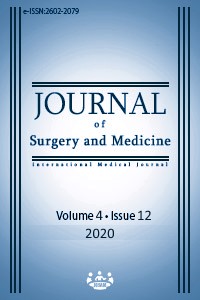Retropharyngeal approach in cervical disc hernias
Keywords:
Cervical disc hernia, Anterior retropharyngeal approach, dysphagiaAbstract
Aim: High-level disc hernias are rare pathologies encountered in clinical practice. Treatment is more difficult than other cervical disc hernias. In this study, we aimed to convey our clinical experience in C2-3 and C3-4 disc herniations, also presenting the complications we encountered during surgical treatment. Methods: In this retrospective cohort study, we reviewed the clinical and radiological records of 42 patients we operated between 2010-2019. Magnetic resonance imaging, computed tomography and direct radiographs were utilized as imaging modalities. Anterior retropharyngeal approach was the preferred surgical method. The modified Japanese Orthopedic Association (mJOA) score and Nurick Scale were used in clinical follow-up and physical examination of these patients. Results: Among all patients, the most common symptom was severe pain radiating from the neck to the occipital region. The mean age was 54.14 years. The average mJOA scores were 15.1 in the preoperative period and 17 in the postoperative sixth month. We observed that 83.3% of our patients had an mJOA recovery rate of fifty percent and above. All but seven patients’ complaints improved well after treatment. There was a negative correlation between symptom duration and recovery rate (P=0.003, Correlation Coefficient r=-0.449). The rate of recovery was lower in patients with a longer duration of symptoms. Three of our patients developed difficulty in swallowing after the operation and recovered within four weeks with diet and exercise. Conclusion: We determined that retropharyngeal approach is a safe option for disc hernias at the upper cervical level. However, long operation time and excessive retraction during surgery may lead to complications such as difficulty in swallowing due to the stretching of the neural structures.
Downloads
References
Jomin M, Lesoin F, Lozes G, Thomas CE 3rd, Rousseaux M, Clarisse J. Herniated cervical discs. Analysis of a series of 230 cases. Acta Neurochir (Wien). 1986;79(2-4):107-13.
McAfee PC, Bohlman HH, Riley LH Jr, Robinson RA, Southwick WO, Nachlas NE. The anterior retropharyngeal approach to the upper part of the cervical spine. J Bone Joint Surg Am. 1987 Dec;69(9):1371-83.
Nishizawa S, Yokoyama T, Yokota N, Kaneko M. High cervical disc lesions in elderly patients--presentation and surgical approach. Acta Neurochir (Wien). 1999;141(2):119-26.
Russo A, Albanese E, Quiroga M, Ulm AJ. Submandibular approach to the C2-3 disc level: microsurgical anatomy with clinical application. J Neurosurg Spine. 2009 Apr;10(4):380-9.
Park SA, Lee JH, Nam YS, An X, Han SH, Ha KY. Topographical anatomy of the anterior cervical approach for c2-3 level. Eur Spine J. 2013 Jul;22(7):1497-503.
Shim CS, Jung TG, Lee SH. Transcorporeal approach for disc herniation at the C2-C3 level: a technical case report. J Spinal Disord Tech. 2009 Aug;22(6):459-62.
Skaf GS, Sabbagh AS, Hadi U. The advantages of submandibular gland resection in anterior retropharyngeal approach to the upper cervical spine. Eur Spine J. 2007 Apr;16(4):469-77.
Türe U, Güçlü B, Naderi S. Anterolateral extradural approach for C2-C3 disc herniation: technical case report. Neurosurg Rev. 2008 Jan;31(1):117-21; discussion 121.
Finn MA, MacDonald JD. C2-C3 Anterior Cervical Fusion: Technical Report. Clin Spine Surg. 2016 Dec;29(10): E536-E541.
Hirabayashi K, Satomi K. Operative procedure and results of expansive open-door laminoplasty. Spine (Phila Pa 1976). 1988 Jul;13(7):870-6.
Kotil K, Sengoz A. The management in the C2-C3 disc herniations: a clinical study. Turk Neurosurg. 2011 Jan;21(1):15-21.
Anderson KK, Arnold PM. Oropharyngeal Dysphagia after anterior cervical spine surgery: a review. Global Spine J. 2013 Dec;3(4):273-86.
Logemann JA, Larsen K. Oropharyngeal dysphagia: pathophysiology and diagnosis for the anniversary issue of Diseases of the Esophagus. Dis Esophagus. 2012 May;25(4):299-304.
Orestes MI, Chhetri DK. Superior laryngeal nerve injury: effects, clinical findings, prognosis, and management options. Curr Opin Otolaryngol Head Neck Surg. 2014 Dec;22(6):439-43.
Park SH, Sung JK, Lee SH, Park J, Hwang JH, Hwang SK. High anterior cervical approach to the upper cervical spine. Surg Neurol. 2007 Nov;68(5):519-24; discussion 524.
Fard SA, Patel AS, Avila MJ, Sattarov KV, Walter CM, Skoch J, et al. Anatomic considerations of the anterior upper cervical spine during decompression and instrumentation: a cadaveric based study. J Clin Neurosci. 2015 Nov;22(11):1810-5.
Downloads
- 366 810
Published
Issue
Section
How to Cite
License
Copyright (c) 2020 Şükrü Oral
This work is licensed under a Creative Commons Attribution-NonCommercial-NoDerivatives 4.0 International License.
















